On the Map
Community Profile No. 1
November 2014
The Growing Gap: New York City’s Housing Affordability Crisis, a 2014 report released by the New York City Office of the Comptroller, confirms what has long been known to New Yorkers: the city is becoming increasingly unaffordable. Rents have increased citywide—dramatically in many neighborhoods—while wages have not kept pace. The soaring cost of living is no longer limited to expensive or gentrifying neighborhoods. As affordable housing becomes ever more scarce and economic pressure increases, working class communities that have historically had few families entering shelter are beginning to show signs of vulnerability such as growing poverty, declining educational attainment, and rental overcrowding. One such neighborhood is Sunset Park, Brooklyn (see Table 1 and Figure 1). This report from the Institute for Children, Poverty, and Homelessness examines demographics associated with the risk of family homelessness and neighborhood changes that are indicators of destabilization.1
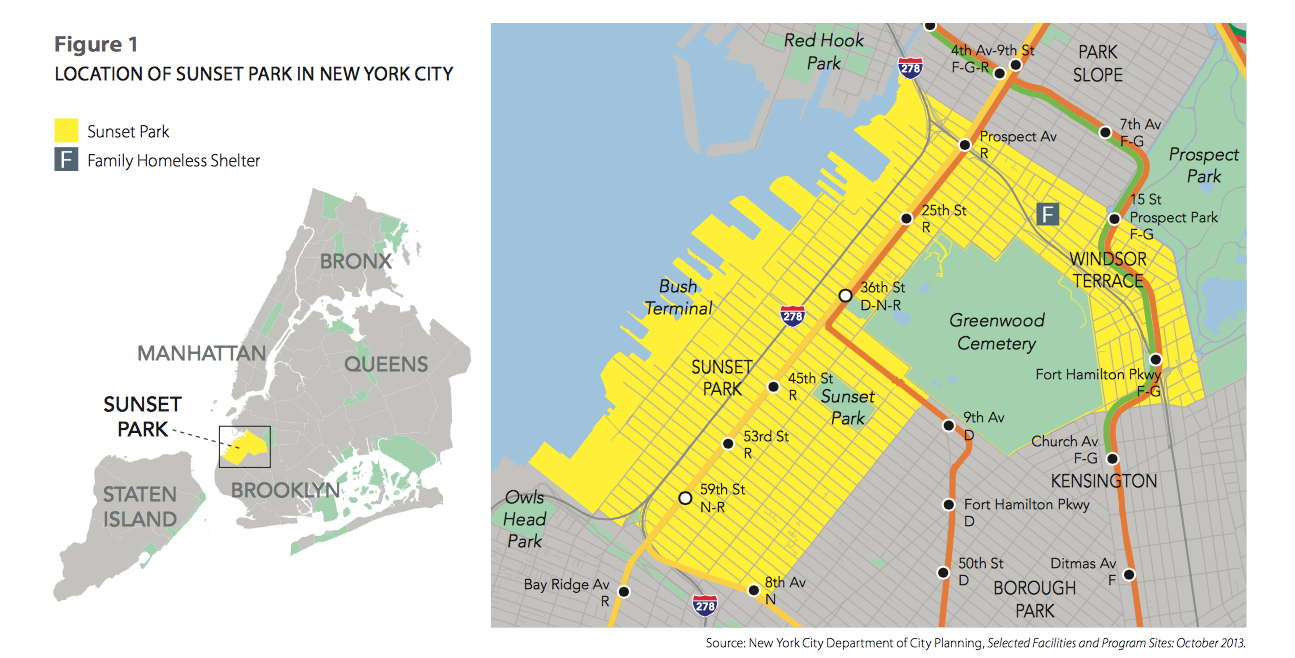
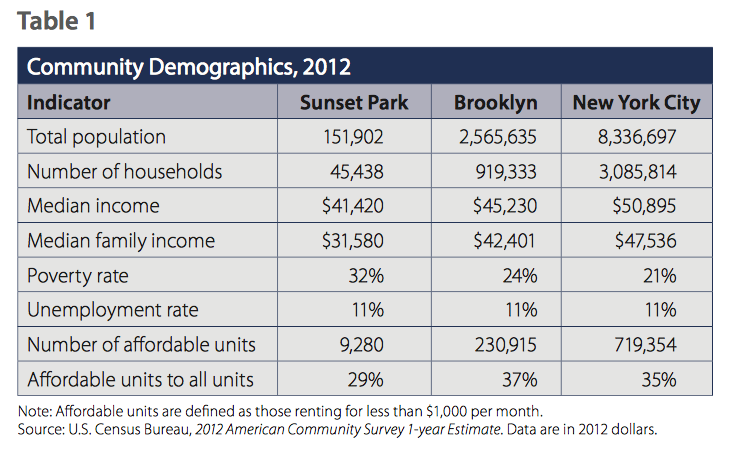
Changing Demographics in a Changing Neighborhood
In recent years, Sunset Park, while not changing at the same rate as gentrifying neighborhoods like Bushwick and Williamsburg, has seen subtle population shifts. From 2000 to 2012, the number of households earning over $100,000 rose from 6,490 to 8,006—an increase of 23%. Despite this change, the neighborhood remained solidly working class. In 2012, 73% of the population worked in non-managerial positions and only 18% of households earned more than $100,000. Two-thirds of Sunset Park residents had completed only high school or less. Although the proportion of residents completing more than high school remained relatively stable between 2005 and 2012, the neighborhood experienced an overall trend of declining educational attainment. The population with a high school diploma fell from 27% to 19% while those completing less than high school rose from 37% to 43% (see Figure 2).2
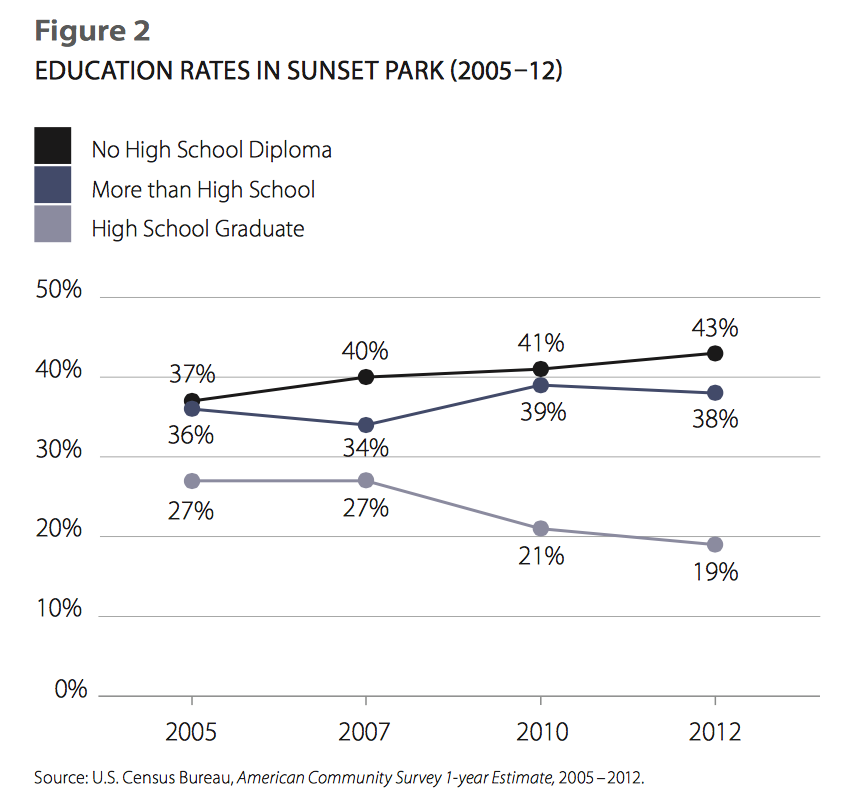
Over half (55%) of households earned incomes below 200% of the federal poverty level, or $36,996 for a family of three, compared with 37% of all New York City households (see Figure 3). In 2012 the median household income was $41,420—nearly $10,000 (or 19%) less than the figure for the city overall (see Figure 4).
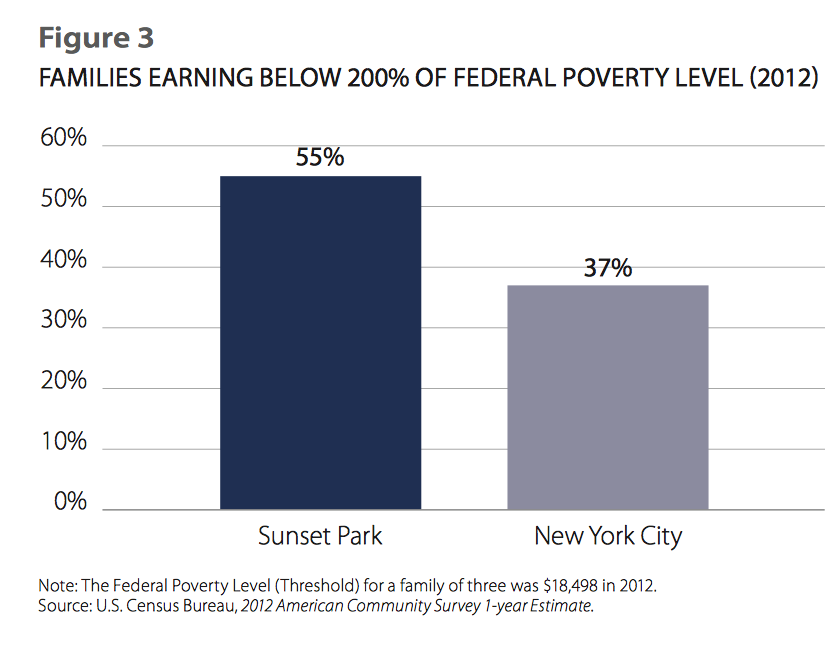
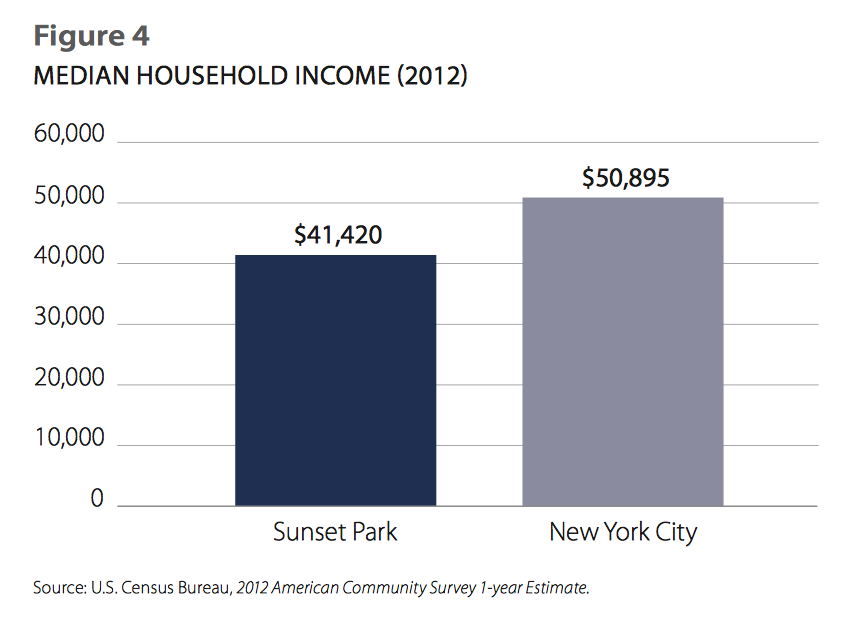
Families with children made significantly less, earning just $31,580 annually, and nearly one in three (32%) lived below the poverty line ($18,498 for a family of three), a much higher rate than the city overall (21%) (see Figure 5).3
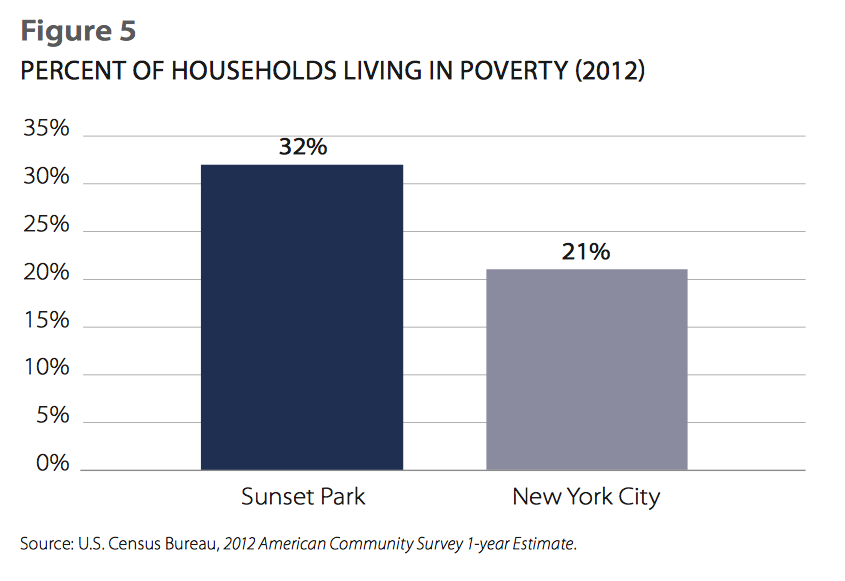
Over the last 12 years, Sunset Park’s median rent has kept pace with the city’s rate of increase (31%), but wage growth has remained relatively stagnant and median income for families with children declined by close to $6,000 (or 16%) from 2005 to 2012 (see Figure 6).4
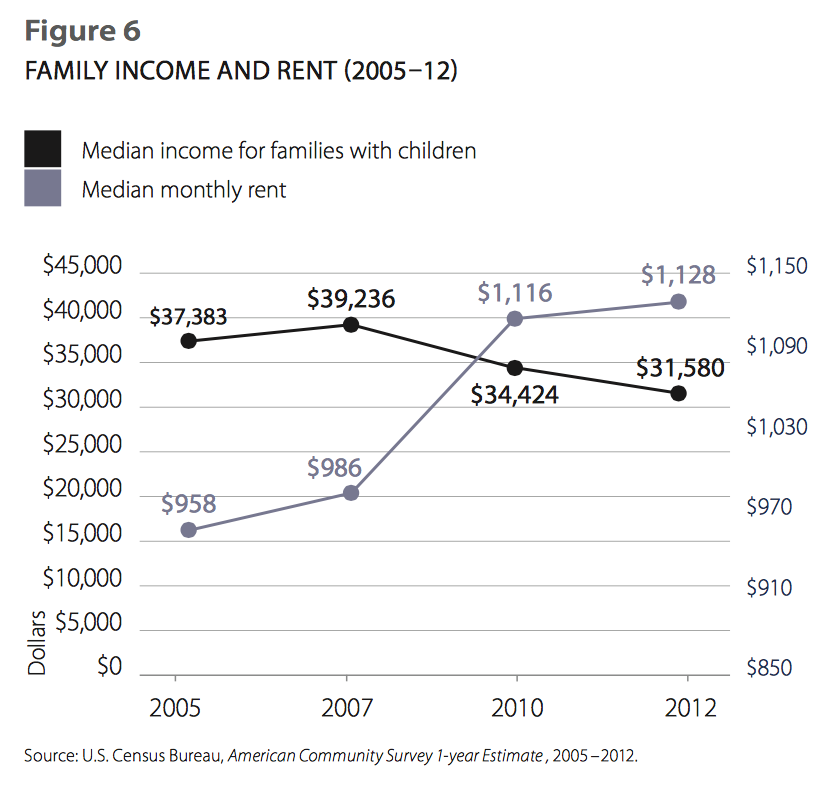
This pattern has lead to an increase in rent burden, or those paying more than 30% of their income to maintain their housing, and in 2012 Sunset Park was the fourth most rent-burdened community in New York City (when compared to all other 59 city community districts). Nearly 38% of households were severely rent burdened and paid more than half of their income on housing (see Figure 7).5
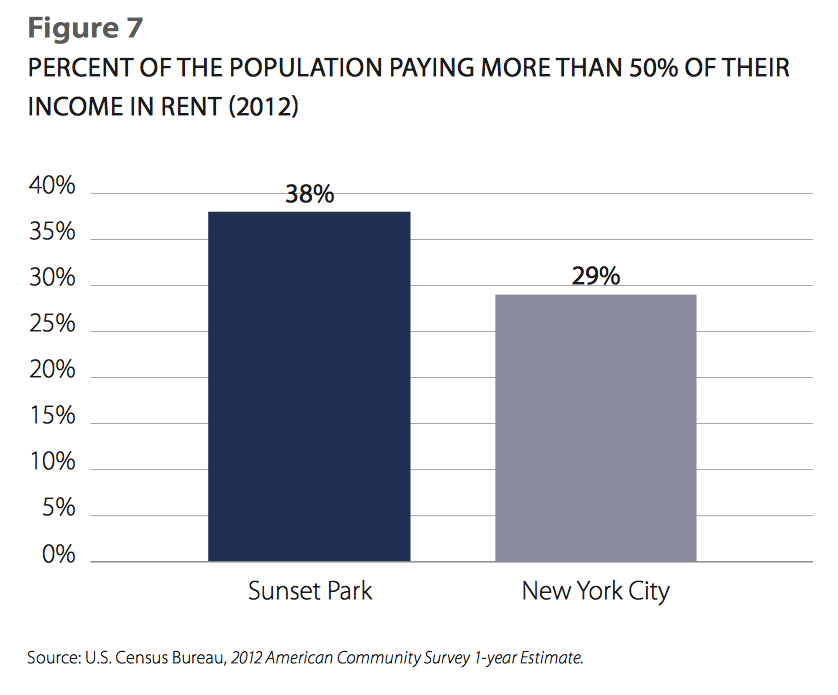
Potentially furthering the economic strain faced by residents in the neighborhood, more than 600 units of project-based Section 8 affordable housing are in danger of being lost by 2016 as they become eligible to transition to market value. If this happens, it would be the equivalent of a 7% decrease in affordable housing units in Sunset Park.6
Past the Tipping Point?
New York City is now grappling with a family homelessness crisis. The number of families living in shelter has risen from over 7,000 in March 2008 to over 12,000 in November 2014. Amidst these growing numbers, few Sunset Park families to date have turned to the shelter system for assistance. The neighborhood is home to only one small six-unit family shelter and, of the almost 12,000 families who entered shelter in Fiscal Year 2014, only 47 were from Sunset Park.7
What these numbers do not reveal, however, is the number of families in the neighborhood who have become homeless and are living doubled up in someone else’s apartment due to economic hardship. While little information exists about this group of homeless families, one indicator that sheds light on neighborhood trends for those living doubled up is the rate of overcrowded rental units. These numbers paint a very different picture of Sunset Park than shelter entry data suggest. With 23% of all rental units in Sunset Park overcrowded in 2012, Sunset Park was the most overcrowded neighborhood of the city’s 59 community districts.8
This data, combined with increases in the number of homeless schoolchildren in the surrounding area—which includes not only those in shelter but students living doubled up—suggests growing housing instability in the area. In just six years, the number of homeless students in school districts 15 and 20 combined, which serve Sunset Park and the nearby neighbor- hoods of Carroll Gardens, Park Slope, Bay Ridge, and Borough Park (see Figure 8), more than doubled, from 1,689 to 3,765, an increase of 122% from SY 2007–08 to SY 2012–13 (see Table 2). While not exclusive to Sunset Park, this growth in student homelessness is twice that of New York City as a whole, which was close to 60% for the same period. These data suggest not only increasing housing instability, but also growing vulnerability among Sunset Park’s children.9
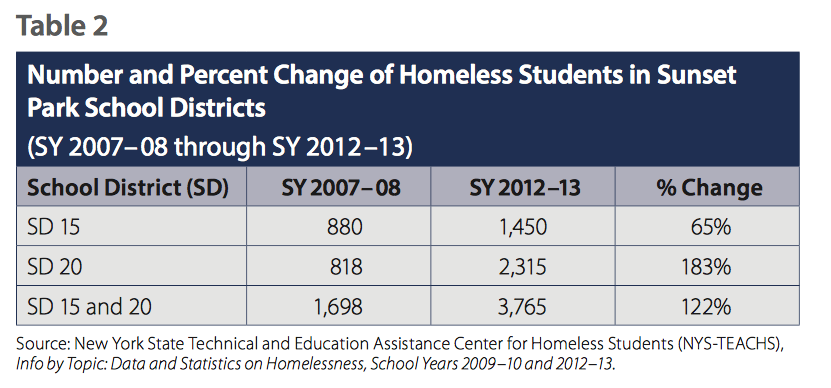
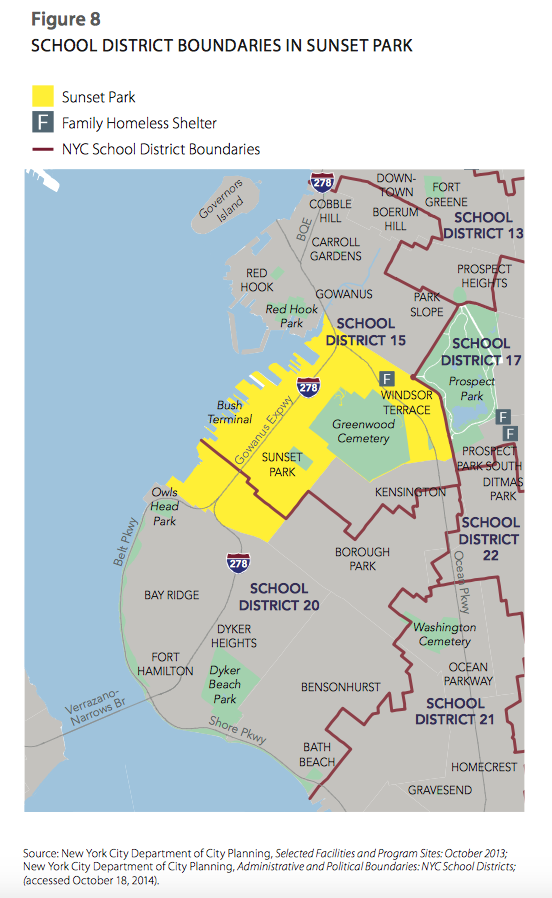
Rising rents without corresponding wage increases, high poverty, declines in high school graduation rates, and increases in rent burden are a possible recipe for destabilization even in a neighborhood that has historically had few families entering shelter. Whether or when Sunset Park will cross its tipping point is unclear, but the warning signs are present. For Sunset Park and other neighborhoods across New York City, the identification of factors that lead to community vulnerability and destabilization can be used to inform city policies. If these warning signs are ignored, once stable neighborhoods could become the next feeders of New York City’s family shelter system.
For more information, see On the Map: The Atlas of Family Homelessness in New York City at www.ICPHusa.org and join the conversation at #OnTheMap or @ICPH_homeless.